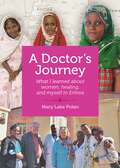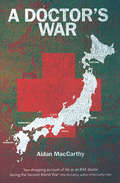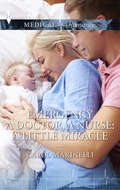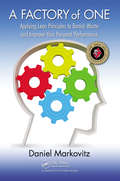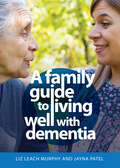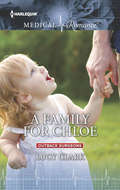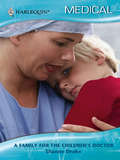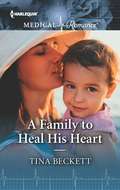- Table View
- List View
A Doctor to Come Home to: A Heartwarming Medical Romance (Medical Romances #1)
by Gill SandersonAnother dreamy medical romance from best-selling author Gill Sanderson! Perfect for fans of Mia Faye, Laura Scott, Helen Scott Taylor, Grey's Anatomy and ER.Readers LOVE Gill's gripping medical romances!'Remarkable writer!!' 5* author review 'Brilliant book filled with romance, love, adventure and wonderment!' 5* reader review'This is a very heartwarming book which I struggled to put down. Worthwhile read' 5* reader review Could this be just a holiday romance...District Nurse Amy Harrison didn't want a man in her life. She had a husband and it wasn't a happy experience. Now content with her family and career, a holiday in Majorca turns things on its head when she meets Doctor Adam Ross and his daughter. There is something different about Adam. Somehow he has managed to open her heart and left her yearning for his love. But is this the real deal, or just a brief love affair?Don't miss Gill Sanderson's enthralling medical romances, including the A Lakeland Practice and the Good, Bad and Ugly series.
A Doctor's Courage
by Gill SandersonNewly arrived G.P. Tom Murray finds himself both neighbour and colleague of Nurse Nikki Gale at the same country practice. He a stranger; she a local girl who, as she shares her passion for the area, becomes increasingly fascinated by this man. But what is his secret? Why is he sometimes so distant? He seems intent on halting their growing relationship. The shocking truth? Time is short and he dare not hurt the woman he desires. A dramatic rescue and Nikki's determination - are they enough to give Tom the courage to face the future and the chance to love and be loved?
A Doctor's Courage: A Heartwarming Medical Romance
by Gill Sanderson<p>Newly arrived G.P. Tom Murray finds himself both neighbour and colleague of Nurse Nikki Gale at the same country practice. He a stranger; she a local girl who, as she shares her passion for the area, becomes increasingly fascinated by this man.<p> <p>But what is his secret? Why is he sometimes so distant? He seems intent on halting their growing relationship.<p> <p>The truth? Time is short and he dare not hurt the woman he desires. A dramatic rescue and Nikki's determination - are they enough to give Tom the courage to face the future and the chance to love and be loved?<p>
A Doctor's Journey: What I Learned About Women, Healing, and Myself in Eritrea
by Mary Lake PolanDr. Mary Lake Polan takes us on a compelling journey into Eritrea, where she started a surgical clinic to offer life-changing care to African women. She and her team repair fistulas, a condition that results from traumatic births and leads many African women to lives of stigma and shame. Dr. Polan describes how she and her surgical team offered the care and compassion that forever changed the lives of their African patients, in a story that will inspire readers to believe that they, too, can make a difference.
A Doctor's Quest: The Struggle for Mother and Child Health Around the Globe
by Gretchen Roedde Dr John EvansA doctor grapples with the challenges of mother and child health in the developing world. Recounting medical missions in half of the thirty countries in which she has worked for the past twenty-five years in Africa, Asia, and the South Pacific - from Darfur in Sudan to Papua New Guinea and Bhutan - Dr. Gretchen Roedde shares the grim reality of world politics and bureaucratic red tape on the front lines as a doctor in mother-and-child health and HIV/AIDS.A Doctor’s Quest tells the stories of the hopes of village women struggling to give birth safely, their often corrupt leaders, and countries trying to bring evil despots to justice. The book analyzes the slow progress in global maternal health, contrasting the affluence of the few with the precarious hold on survival of the world’s poorest, where economic realities force families to sell young girls into marriage at the age of thirteen to face higher risk of death from early child-bearing.
A Doctor's Quest: The Struggle for Mother-and-Child Health Around the Globe
by Gretchen RoeddeA doctor grapples with the challenges of mother-and-child health in the developing world. Recounting medical missions in one-third of the forty-five countries in which she has worked for the past thirty years in Africa, Asia, and, the Caribbean, and the South Pacific, Dr. Gretchen Roedde shares the grim reality of world politics and bureaucratic red tape on the front lines as a doctor in mother-and-child health and HIV/AIDS. This second edition updates the progress in reproductive, maternal, newborn, child, and adolescent health (RMNCAH), with additional studies in Afghanistan, Laos, South Sudan, and Nigeria. It tells the stories of the hopes of village women struggling to give birth safely, of their often corrupt leaders, and of countries trying to bring evil despots to justice. Roedde analyzes the encouraging momentum in global maternal health while maintaining a focus on equity disparities within and between countries.
A Doctor's War
by Aidan MacCarthyAn &“engrossing&” memoir of a Royal Air Force doctor&’s World War II experiences, from surviving Dunkirk to witnessing Nagasaki (The Irish Times). As an RAF medical officer, Aidan MacCarthy served in France, survived Dunkirk, and was interned by the Japanese in Java, where his ingenuity helped his fellow prisoners through awful conditions. While en route to Japan in 1944, his ship was torpedoed, sending him into the Pacific. Miraculously, MacCarthy was rescued by a whaling boat—only to be re-interned in Japan. Ironically, it was the dropping of the atomic bomb at Nagasaki that saved his life, though it also meant being an eyewitness to the horror and devastation it caused. Long out of print, this remarkable war memoir was rediscovered during a journey through Ireland by Pete McCarthy, author of McCarthy&’s Bar, who describes it as &“jaw-dropping.&” &“Written in a straightforward, matter-of-fact tone, this book is marked by the author&’s ability to keep cool under adversity and by his admirable sense of humor and irony. A wonderful, if chilling work.&” —Publishers Weekly &“A gripping read.&” —Evening Echo
A Doctor, A Nurse: A Christmas Baby
by Amy AndrewsPediatric nurse Maggie Green is devoted to the children on the intensive care ward at Brisbane's Children's Hospital. Nash Reece is a top-notch doctor with a reputation as a heartbreaker. He's attracted to Maggie--and, for the first time, one night just isn't enough. For this confirmed bachelor Maggie is trouble. . . and he can't resist her!It's Christmas--a time for miracles--and Maggie's dreams of motherhood are about to come true. But how will Nash react to Maggie's Christmas baby bombshell?
A Doctor, A Nurse: A Little Miracle
by Carol MarinelliNurse Molly Jones had decided that if she ever bumped into Luke Williams again, she'd be superslim, sleek-haired and dressed to impress... Instead Molly's coming off a night shift in the children's ward, and is slightly the worse for wear when she discovers that Luke is back in town--with his four-year-old twins! Luke, a single dad and pediatrician, is asdedicated and charming as she remembers. But Molly's heart's been broken twice before: first when Luke left, and then when she discovered that she'd never be a mom. All she's ever dreamed of is having a family, and Luke makes it all seem possible...especially when Molly realizes they've made a little miracle of their own.
A Dublin Student Doctor: An Irish Country Novel (Irish Country Series Book #6)
by Patrick TaylorPatrick Taylor's devoted readers know Doctor Fingal Flahertie O'Reilly as a pugnacious general practitioner in the quaint Irish village of Ballybucklebo. Now Taylor turns back the clock to give us a portrait of the young Fingal--and show us the pivotal events that shaped the man he would become. In the 19305, fresh from a stint in the Royal Navy Reserve, and against the wishes of his disapproving father, Fingal O'Reilly goes to Dublin to study medicine. Fingal and his fellow aspiring doctors face the arduous demands of Trinity College and Sir Patrick Dun's Hospital. The hours are long and the cases challenging, but Fingal manages to find time to box and play rugby--and to romance a fetching, gray-eyed nurse named Kitty O'Hallorhan. Dublin is a city of slums and tenements, where brutal poverty breeds diseases that the limited medical knowledge of the time is often ill-equipped to handle. His teachers warn Fingal not to become too attached to his patients, but can he truly harden himself to the suffering he sees all around him--or can he find a way to care for his patients without breaking his heart? A Dublin Student Doctor is a moving, deeply human story that will touch longtime fans as well as readers who are meeting Doctor Fingal O'Reilly for the very first time. Read all of the irresistible books in the Irish Country Doctor including: #1 An Irish Country Doctor, #2 An Irish Country Village, #3 An Irish Country Christmas, #4 An Irish Country Girl and, #5 An Irish Country Courtship and #7 An Irish Country Wedding.
A Factory of One: Applying Lean Principles to Banish Waste and Improve Your Personal Performance
by Daniel MarkovitzMost business readers have heard of the Lean principles developed for factories a set of tools and ideas that have enabled companies to dramatically boost quality by reducing waste and errors producing more while using less. Yet until now, few have recognized how relevant these powerful ideas are to individuals and their daily work. Every person at
A Family Again: A Heartwarming Medical Romance (Three Sisters Series #1)
by Gill SandersonThe second novel in Gill Sanderson's delightful Three Sisters trilogy, perfect for fans of Mia Faye, Laura Scott, Helen Scott Taylor, Grey's Anatomy and ER.Readers LOVE Gill's gripping medical romances!'An excellent book with many interesting twists and turns to the story' 5* reader review'Enjoyed this second book in the 3 sister's series... Can't wait for the last book to see how it all comes together' 5* reader review'A truly wonderful writer' 5* author review Three caring sisters, in need of a loving family...Emily was amazed to find herself kissing Dr Stephen James. After coming to Africa to forget men after her marriage had failed, the last thing she needed was to fall for a man who was returning to England in two weeks. So when Stephen asked for more, Emily had to say no. Soon enough Emily was forced to return to England herself, and was extremely surprised to discover that Stephen was her new boss! Emily had been given a second chance, and this time she wanted to say yes.Don't miss Gill Sanderson's enthralling medical romances, including the A Lakeland Practice and the Good, Bad and Ugly series.
A Family Friend: A Heartwarming Medical Romance (Three Sisters Series #3)
by Gill Sanderson<p>Three caring sisters, in need of a loving family...<p> <p>The youngest of three sisters, Rosalind, was used to fighting for what she wanted, and Mark was going to be no exception! Rosalind believed that he was the man for her - funny, intelligent, and gorgeous!<p> <p>However, Mark was her boss and ten years her senior. Rosalind had her whole career before her and Mark had decided that getting involved wouldn't be fair on her. But Rosalind had never let anyone make her decisions for her and she wasn't about to start now.<p>
A Family Genogram Workbook
by Israel Galindo Elaine Boomer Don ReaganA Family Genogram Workbook, by Israel Galindo, Elaine Boomer, and Don Reagan, is an easy to use, but powerful, guide to understanding your family and how it shaped you. This workbook will take you step-by-step to learn how to create your own family genogram. A genogram is an exciting tool for understanding and interpreting family history and relationships. By working through various exercises and activities in A Family Genogram Workbook you will gain insight into your family and your place in it. The workbook has four chapters. The first, a tutorial, shows readers, step-by-step, how to create their own family genogram so that they can quickly reap the benefits of this powerful tool for understanding family emotional process. The workbook format contains work pages so the reader can create a genogram right in the book. Subsequent chapters provide basic information on how to interpret and how to use the genogram. The chapter titled The 20 Questions to Ask About Your Family will help readers focus on key issues related to family emotional process. By working through various exercises and activities in A Family Genogram Workbook readers will gain insight into their families, how they work, and their place in it. Along the way, readers will also acquire an understanding of basic Family Systems Theory concepts and terminology. This resource is suitable for courses on family systems, social work practice, individual or group study, marriage and family retreats or workshops, for premarital counseling with couples or blended families, coaching relationships, or for personal use.
A Family Guide to Living Well with Dementia
by Liz Leach Murphy Jayna PatelGain the knowledge and insight you need to support your loved one with dementia to live life as they wish. When a family member is diagnosed with dementia it’s difficult to know what to do. Do you worry you don’t have the skills and knowledge to support them? And what about looking after your own mental health?A Family Guide to Living Well with Dementia is here to help. Written by someone with lots of experience in this field, it gives you the knowledge and insight to be able to support the person with dementia to live life as they wish. This easy-to-follow and accessible guide contains information that is intended to support people to plan for how they want to live their life, receive their care, and for end-of-life planning.In this book you will find: Details of the different types of dementia and the dementia journey Explanations of the various Person Centred approaches to dementia care Information about people's rights within the health and social care legislation Insights into behaviour and methods of communication Support options available to you and your loved one, paid and community-based. Often people who have been diagnosed with dementia and their families report feeling lost and not sure what to do apart from learning to adapt and find a way to do their best in what can often be difficult circumstances. This book provides easy, engaging, and practical content for things to consider and conversations to have so as to be able to provide the best care and support on a basis of sound understanding from everyone involved.
A Family Made in Rome (Double Miracle at St. Nicolino's Hospital #1)
by Annie O'NeilCan one last night in New YorkLead to a new beginning in Rome?When Leon Cassanetti is called on to perform pioneering surgery on conjoined twins, he knows who he wants by his side—his ex, Lizzy Beckley. Their history is complicated…but Lizzy is honored to join Leon in Rome to save these babies. Only first she must deliver a baby bombshell of her own to this career-driven bachelor!A Double Miracle at St Nicolino's Hospital novelDouble Miracle at St Nicolino's Hospital duetBook 1 - A Family Made in Rome by Annie O&’NeilBook 2 – Reawakened by the Italian Surgeon by Scarlet Wilson&“This was a genuinely lovely story and it had some wonderful characters. It is 5 stars from me for this one, very highly recommended and this was a nice wholesome read!&”-Goodreads on Christmas Under the Northern Lights&“With her poignant way of wrapping a character around her reader's heart, Annie O'Neil does it once again in Risking Her Heart on the Single Dad. The emotion is high throughout the story, and the characters are well developed and inspiring. I highly recommend this book to anyone who loves a medical romance filled with emotion and heart.&”-Goodreads
A Family This Christmas
by Sue MackayThe greatest gift of all... The sleepy town of Havelock is the last place Dr. Jenny Bostock wants to get stuck over the holidays. Her whole trip has been designed to escape the heartbreak of a family Christmas. But when an adorable boy crashes into her on his skateboard-closely followed by his twin and their stressed-out (and seriously sexy!) single dad, Dr. Cameron Roberts-Jenny's forced to put her traveling plans on hold. And the longer she stays with Cameron and his two little boys, the harder it is to leave...
A Family for Chloe
by Lucy ClarkSingle dad in the Outback Becoming a dad to his niece Chloe changes hotshot surgeon Felix McLaren's whole world. Wanting the best for her, Felix heads for the Outback. But nothing about his new life is as he expected, and when beautiful registrar Harriette Jones bonds with him over little Chloe, everything changes. Harriette's determined to focus on her future, but Felix and adorable little Chloe pull on her heartstrings. Is it possible they're what she's been missing all along...and that she's the final piece of their family?
A Family for His Tiny Twins
by Josie MetcalfeNurse Nadia Smith is devoted to the fragile lives in the neonatal intensive care unit. The loss of her own baby has made her care that much more for her tiny patients. Her heart becomes particularly attached to a special set of twins. . . and their daddy. Single dad Dr. Gideon West refuses to leave the sides of his premature newborn twins for even a second. They are the most precious things in the world. Nadia is taken with the gorgeous doctor, and it is clear to Gideon she has already fallen head over heels in love with his beautiful babies. It's not long before he begins to realize what a wonderful wife and mother Nadia would make--if only she would open her heart to him.
A Family for the Children's Doctor
by Dianne DrakeTwo and two make one very special familyFor renowned plastic surgeon and single mother Caprice Bonaventura, her volunteer work with children is a lifeline. Spending all her free time with her young patients and daughter means she has no chance to admit she might be missing out in other areas of life...Then she meets the handsome and caring Dr. Adrian McCallan, with whom she shares the experience of being a single parent. Adrian sets her senses alight in a way no man has before. Though breaking down his emotional barriers means putting her heart on the line, Caprice knows it will be worth the risk!
A Family of Their Own
by Jennifer TaylorThe family they need Nurse Leanne Russell leaves her native Australia in search of her real mother--and finds Dr. Nick Slater. Being adopted, she's dreamed of a family of her own-- now she knows she wants a family with Nick. Nick is deeply attracted, hopelessly tempted, but he's vowed never to marry. It wouldn't be fair to have children of his own, and it wouldn't be fair, either, to give in to his desire for this woman--unless his love for Leanne is enough to persuade him to take a chance on the family they both desperately need.
A Family to Come Home To
by Josie MetcalfeSingle father, single mother--a very special family!Dr. Kat Leeman is so relieved to finally hire a temporary physician. Running a busy surgery and bringing up two lively boys by herself was starting to take its toll. Single father Dr. Ben Rossiter is just perfect for the job, even if he is also distractingly handsome! Ben and his daughter never settle anywhere for too long. But there is something about Kat and her sad gray eyes that make him want to stay. Can Ben face his past and heal Kat's heart? If so, they both may finally have a very special family to come home to.
A Family to Heal His Heart
by Tina BeckettCan this nurse and her daughter……mend his broken heart?Brooding surgeon Zeke Bruen never got over the death of his daughter and has vowed to protect his heart ever since. But when he meets nurse Lindy Franklin and her gorgeous little girl, Daisy, his resistance begins to crumble. Soon they’re sharing a passionate kiss, and Zeke begins to believe that they might have a future. But can he let go of the past and find his forever family?“Every medical romance I’ve read by Ms. Beckett has entertained me from start to finish, as she writes complex characters with interesting back stories, compelling dialogue that has me enjoying the growing relationship between the two main characters, and challenging obstacles for the characters to overcome and this story was no different.”— Harlequin Junkie on One Night to Change Their Lives“For me this one ticked a lot of boxes…. I really enjoyed this story it is moving and very sensual…the setting is fabulous and the HEA just beautiful…this is a book that any lover of medical romances will enjoy, I do highly recommend this one.”— Goodreads on Tempted by Dr. Patera
A Family to Share: A Heartwarming Medical Romance (Three Sisters Series #2)
by Gill Sanderson<p>Three caring sisters, in need of a loving family...<p> <p>Sister Lisa Grey loved her work on the Infectious Diseases Unit, but she knew there was something missing in her life. She had been the linchpin of her family after her mother's death, but when she met Dr Alex Scott and his two small children, Holly and Jack, she realised she badly wanted to share in his family too.<p> <p>The children were willing, so was their grandmother who cared for them, and so was Lisa -but what about Alex?<p>
A Fatal Debt
by John GapperThis timely debut thriller by an award-winning Financial Times columnist is a gripping tale of lethal intrigue set in the high-stakes Wall Street world--where wealth and privilege are no match for jealousy and betrayal. Ben Cowper, an attending psychiatrist at the prestigious New York-Episcopal Hospital, is stunned to learn the identity of the emergency patient he's just been assigned to treat: Harry Shapiro, a Wall Street colossus and one of Episcopal's most prominent donors. But a high-profile reversal of fortune has left the once powerful investment banker jobless, bitter, and possibly desperate--judging by the handgun his wife finds him clutching. In Ben's expert opinion, Shapiro is a suicide waiting to happen. But when the headstrong financier balks at an extended stay in the hospital psych ward, Ben reluctantly releases him, bowing to political pressure from Episcopal's chief administrator, who's more concerned with the patient's money than his mind. Days later, the shocking news breaks: There's been a shooting death in Harry Shapiro's Hamptons mansion. But even more shocking is the identity of the victim. A tragedy sets in motion an explosive chain of events that turns Ben Cowper's life upside-down. As hard-nosed cops close in with harder questions, the hospital closes ranks to protect its own interests. But with colleagues freezing Ben out, innocent circumstances conspire to incriminate him. Hounded by a DA who's out for blood, and haunted by the specter of a shattered career, Ben has no choice: He must delve into the hearts and minds of the people who know Harry best, uncover the secrets they'd rather die--or kill--to keep, and expose the truth behind a web of malice disguised as madness.



